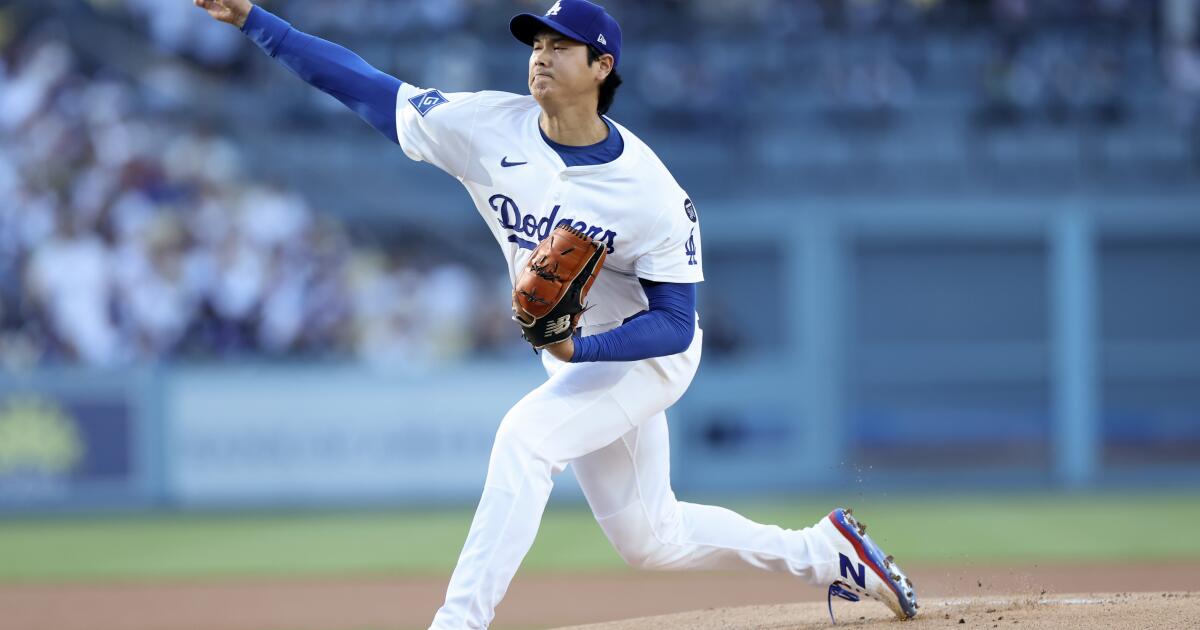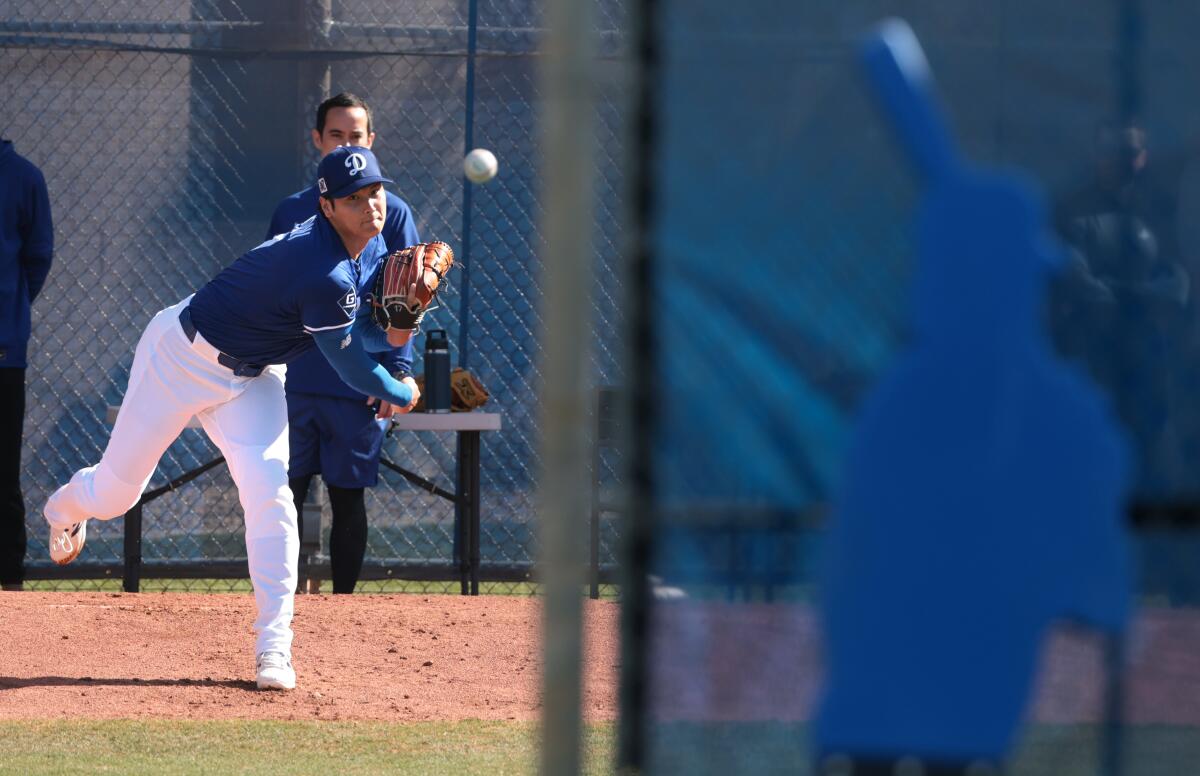Shohei Ohtani pitches like an ace as Dodgers sweep the Reds
Ever since resuming two-way duties earlier this year, Shohei Ohtani had been throwing the ball well.
It wasn’t until Wednesday, however, that he finally pitched like a frontline starter, too.
Coming off his second career Tommy John surgery this year, Ohtani immediately lit up the radar gun with 100-mph fastballs and amassed gaudy strikeout totals with a devastating sweeper. In his first eight pitching starts of the season, he gave up just five runs in 16 innings for a 2.37 ERA, racked up 25 punchouts against just five walks, and looked every bit of the hard-throwing ace he was before spending a year-and-a-half rehabbing his right elbow and only serving as a designated hitter.
But, during that time, Ohtani was also throwing in only short bursts, as part of a deliberate effort to slowly build him up. He tossed one inning in his first two starts. Two innings, then three, then four, in each pair of outings after that. Rarely did he face a lineup two times through. At no point did he see the same batter three times in the same game.
He was, in effect, an opener.
And in that role, raw stuff was enough.
Recently, however, Ohtani had encountered a new challenge. Since getting the green light to make more typical five-inning starts, he had failed to actually complete the fifth in his first two attempts.
The struggles weren’t surprising, with five of the nine runs Ohtani had given up in his previous two outings coming in either the fourth or fifth innings. For all of Ohtani’s talent, it was clear there was tactical rust that still needed to be cleared.
“I think we’re still in the [process of] finding out who he is, what he is, getting his bearings for him,” manager Dave Roberts acknowledged ahead of Wednesday’s game.
“But,” the skipper added, “I’m expecting him to get through five [tonight], pitch well and just continue to get better.”
In the Dodgers’ 5-1 win over the Cincinnati Reds, Ohtani was indeed better.
Both in his results, and his process for getting there.
The right-hander not only got through five full innings of one-run ball in an 87-pitch outing — but did so by adopting a new, more unpredictable plan of attack.
Instead of leaning predominantly on fastballs and sweepers as he did earlier this year, Ohtani threw the kitchen sink at the Reds; using his curveball a career-high 23 times and his splitter a season-high 11 times, and all seven of his wicked offerings on at least seven different occasions.
Along the way, Ohtani yielded only two hits (one of them a solo home run from Noelvi Marte in the third), recorded nine strikeouts (his most in a game in more than two years) and, for the first time this year, showed the kind of ability to work deep into a game that could be pivotal in determining his October pitching role.
“Getting his sea legs back and getting going, it takes a while,” Roberts said. “So I thought tonight was one of those nights where he was locked in and worked some things out and really got into a good rhythm.”
Before Wednesday, there was still an open question over how the Dodgers might use Ohtani’s arm in the postseason.
Ideally, he could help headline their star-studded rotation, joining Blake Snell, Yoshinobu Yamamoto, Tyler Glasnow and maybe Clayton Kershaw to form the kind of deep starting pitching arsenal the Dodgers have sorely lacked in recent playoff treks.
But first, he had to show he was capable of navigating an opposing order multiple times.
“I do think that the last few starts, he was pretty predictable,” Roberts said. “And so he was smart enough to kind of suss that out, and get him off the scent.”
Against the Reds (68-66), Ohtani went to his secondary stuff early and often. His 12 curveballs in the first two innings alone were more than he had thrown in his 10 previous outings this year combined. His 34% fastball usage (including sinkers and cutters) was his lowest in a game in almost three years.
“As we’re progressing through this rehab in general, aside from the innings, I just really wanted to be able to incorporate other pitches,” Ohtani said through interpreter Will Ireton. “So that was really the intent going in.”
Ohtani’s command was still shaky, leading to a pair of second-inning walks that he only stranded after back-to-back strikeouts. With one out in the third, he made his lone mistake, leaving a first-pitch cutter to Marte down the middle for a home run that was clobbered to the left-field pavilion.
After that, however, Ohtani found a groove. He retired the final eight batters he faced. He finished his start by getting Cincinnati leadoff man TJ Friedl to ground out in their third meeting of the evening. And he concluded his performance with 14 swings-and-misses overall, the most whiffs he had generated in a game all year.
“He picked and chose when he used his fastball, and it just felt like they couldn’t really figure it out,” Kiké Hernández said. “They looked like they were guessing out there.”
“He’s got so many pitches,” added catcher Dalton Rushing, “and when you throw everything in the zone or around the zone, it just makes you that much better.”
By getting through five innings, Ohtani also qualified for his first pitching win of the season.
The Dodgers (77-57) made sure they didn’t squander it.
After starting the game with nine straight outs against Reds starter Nick Lodolo, the club finally broke the game open with a four-run rally in the fourth, when Ohtani led off with a single and Hernández and Rushing had two-run, bases-loaded singles. Michael Conforto added a solo insurance homer in the eighth. And the bullpen tiptoed in and out of trouble over four scoreless innings of game-sealing relief.
Collectively, the Dodgers set a nine-inning franchise record by combining for 19 strikeouts.
The victory helped the Dodgers grow their National League West lead to two games over the San Diego Padres, who dropped a series rubber match to the Seattle Mariners earlier in the day. It ran the team’s recent winning streak up to four games, its longest since the start of a 21-25 run dating back to July 4.
What was most important, though, was the way Ohtani looked, showing not only the life that remains in his surgically repaired elbow, but his ability to translate it into successful, dominant full-length outings.
“When you’re trying to go through a lineup three times, you’ve got to at times be able to go to different pitches and sequences,” Roberts added. “So, yeah, to continue to build him up and give us options, if we want to get a little bit more length out of him, is certainly helpful.”
Freeman, Call out
The Dodgers were without Freddie Freeman and Alex Call on Wednesday, but are hoping both will be available for their next game on Friday against the Arizona Diamondbacks.
Freeman was absent from the lineup because of a “stinger” in his neck and right shoulder, Roberts said. Freeman has dealt with similar issues before, and Roberts said they wanted to give him the opportunity for two consecutive days off (including Thursday’s off-day) to let it calm down.
Call was also out of the lineup after being removed from Tuesday’s game with a back flare-up. He, too, has dealt with similar issues in the past. Roberts described Call as “day-to-day” and said the team would re-evaluate his status Friday.

